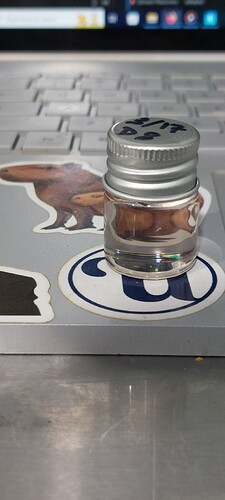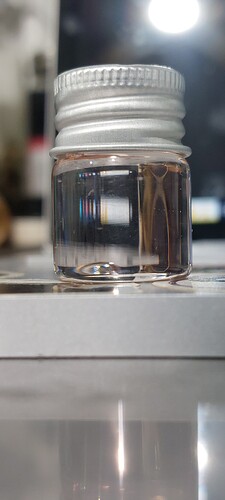Also @chempistry do you find using a quarter of the amount of acid reduces your end yield on conversion?
Cool stuff, I work with someone who used to be a rep there. Was just going to see how you guys liked it to talk to the homie Jay about it.
As far as the solvent thing, the same is true for classical chromatography. It’s just evaporating your peaks.
We had a guy come and help us set it up. Might be the same dude. Maybe 30 years old, dark hair, glasses. I forget his name though.
I meant that with the relative input cost of a 800g input scale FC system (192k MSRP; interchim) that a GCMS (25-30k; Agilent, LabX, etc) is a better investment for a pTSA rxn of CBD → D8 imo, as the rxn is about 18:1 D9:D8 from experience, and even with 6+hr long methods with MeOH/Heptane/Water/Acetone on an interchim 5.105 after waaaaay too much method dev, I deemed it ‘impossible’ to separate D8 from D9 in one chromatographic step at scale. I’m not saying I’m correct or that I can’t be proven wrong, but a GCMS allows for one to really map out the kinetics of the rxn, ensure there are no toxic adulterants in the end product, and provide the tools to figure out many different non-chroma remediation experiments in close to real time to provide a superior product in the D8 market, which I think is a quicker path to NDT D9 D8 disty.
Again, I’m just speaking from my own experience and my knowledge is therefore limited to that, but a fraction of investment in analytics relative to flash chroma provided much more long-term value. However, if by prep-scale you mean things like TLC or DCVC, then yes, you should absolutely have the capability to do cheap/relatively simple experiments like this as well, test the resulting fractions, and perhaps utilize them for things like monitoring your LLE and cleaning up the synthesized crude matrix pre and post distillation.
Given kentucky’s recent unanimous ‘legalization’ of D8 with legal framework in place, I think it’s safe to say that the market isn’t going anywhere, and I look forward to superior/low-cost scaled manufacturing methods being developed relative to the ones I worked on!
Nope! In all honesty, less catalyst = easier rxn at scale imo. Temperature/heat really drives the rxn, both from cbd → intermediate and intermediate → D8 or D9, at the ratio depicted above if the rxn is just allowed to do its thing. This is where kinetics come into play, and again, not to plug the GCMS again, but being able to manipulate variables and test in real time goes so far in understanding how temperature affects things like rxn time, product favorability, required amount of catalyst, required amount of solvent, etc.
To answer your question explicitly, if you are conducting a rxn in which you pour melted CBD into RT heptane at a 1:1 ratio, where your resulting T = 35C at t0, and you add 0.25% pTSA, where the resulting exotherm brings the T of your rxn above, say, 50C (with 1% it’s difficult to keep it under 70C), then you will see negligible differences in both rxn time and D8:D9 ratio.
This, though, is where experience comes into play, and your familiarity with the change in things like color and rxn temperature really aid in knowing when the rxn is ‘complete’ and able to be quenched.
I would honestly bargain with a fair amount of confidence that utilizing even less catalyst at higher temps and/or manipulating variables like solvent ratio to increase catalyst/reactant interaction would shorten the rxn time relative to the conventional 1%/1hr approach. However, I have nothing to bargain other than prior experience, so if any large-scale D8 manufacturers are reading this and would like to lower their COGS, I may just be worth my weight in your NDT liquid gold, and my DMs are open for the chance to prove that…
Yes, GCMS as an analytical tool.
But the question is production scale…you are only using the GCMS to fine tune your rxn.
Once you have your std reaction SOP down, I am assuming you want to produce product on the 100gm/kg scale. It is the bulk or scale of your final purification method which I refer to as Scale.
So KY went legal, Oregon went illegal.
If you have a state that has Marijuana and D9 illegal, but farm bill hemp and all derivative legal, perhaps you can make money making D8?? I would guess any knowing adult would just buy his/her Marijuana on the black market…purified D8 and D9 to not pass the ‘taste” test for a lot of connoisseurs…
Trust me, after seeing the cocktail of 10-20 (sometimes more, especially in the early days…) unknown compounds and isomers in D8 distillate, I stopped consuming it myself. I believe, just as I saw the CO market unfold with 1:1 5mg edibles and CBD-heavy strains 5-6 years ago, that D8 offers the tourist/gateway barrier to entry for cannabis for people that aren’t conventional consumers, but I don’t think it’ll pass any taste test.
I do, however, think that purified D8THC should be explored in more detail given its potential superior uses in the enteric nervous system, specifically as an antiemetic, and its purification is therefore relevant. Also, as a reminder to substantiate this, here’s a study of all the synthetic impurities in the only federally legal/prescribed form of D9THC
Given the above, I think it’s kind of on us to do the research, which is a catch 22, as private companies don’t have massive research budgets, the same access to grants, and exist in a much more saturated/competitive economic environment. On the other hand, people can produce D8 without going through audits, pharma qualifications, regulations, etc and distribute it in a gas station in this current moment of time, meaning that the purification research and resulting consumer safety could affect millions of people.
It’s a weird, thing, man. Weirder to type out. This idea that more purified D9THC is being produced in every single state, naturally, than the 1 federally prescribed, synthesized version, while an entirely new market of semi-synthetic isomers is also competing for market share, but with less strings attached.
There is a term some people in the area use: WEEDO
I am not familiar with the use of D8 as an antiemetic. Per se.
CBDA and THCA…but not D8…
Do you have. Reference to work on subject…ie as D8 preferred? I know there is work on actual anti nausea and then there is work on conditioned nausea in anticipation of one next chemo treatment…where cannabinoids have be looked at….
I’m not even sure of the comparison of D8 to D9 binding to CB1R. The psychotropic effects have been described to me as “mellow”…can D8 get you to the hallucinogenic state that d9 can achieve at high dose?
OK: 03/03/23 update [article…] copy and paste (Molecular and Pharmacological Profiles of the Lesser-Known Phytocannabinoids: Δ8-Tetrahydrocannabinol (Δ8-THC) | CSequence)
Just referencing a relatively old paper from the 90’s; didn’t know it was Mechoulam but that’s probably why I know of it: https://sci-hub.ru/https://doi.org/10.1016/0024-3205(95)00194-B
Here’s something interesting about the gap in binding studies, which I would assume to be the result of our recent discoveries of the modulation of the serotonergic system (which we might never understand…) by cannabinoids.
Abstract:
The use of the intoxicating cannabinoid delta-8-tetrahydrocannabinol (Δ8 -THC) has grown rapidly over the last several years. There have been dozens of Δ8 -THC studies dating back over many decades, yet no review articles have comprehensively covered these findings. In this review, we summarize the pharmacological studies of Δ8 -THC, including receptor binding, cell signalling, in vivo cannabimimetic activity, clinical activity and pharmacokinetics. We give special focus to studies that directly compared Δ8 -THC to its more commonly studied isomer, Δ9 -THC. Overall, the pharmacokinetics and pharmacodynamics of Δ8 -THC and Δ9 -THC are very similar. Δ8 -THC is a partial agonist of the cannabinoid CB1 receptor and has cannabimimetic activity in both animals and humans. The reduced potency of Δ8 -THC in clinical studies compared with Δ9 -THC can be explained by weaker cannabinoid CB1 receptor affinity, although there are other plausible mechanisms that may contribute. We highlight the gaps in our knowledge of Δ8 -THC pharmacology where further studies are needed, particularly in humans.
[No authors listed]Br J Pharmacol. 2023 Jan;180(1):130. doi: 10.1111/bph.15990.
couldn’t access the full link so if someone else can, please share!
@chempistry “(which we might never understand…)” indeed.
Yes, that review is excellent…if anyone can get a downloadable pdf file, please post.
Acid activated earth is usually done with sulfuric acid or muriatic acid, so when your using t41 to isomerize, it’s actually h2so4 or hcl doing the work.
I developed a fairly good process with h2so4 like 5 years ago. Personally I would also suggest going to the pTSA route. Much clearer after the second pass disty and can hit a higher purity.
Both methods have their own unique attributes. pTSA likes to make all colors of the rainbow. Muriatic leads to more d9 until the strength gets too high.
I’ve watched the reaction multiple times with my GC. It goes from CBD to D9 to d8. CBD splits into two peaks as it transitions. If you catch it early you can make damn near pure d9.
This is why I was always trying to get interest for flow chemistry on this topic. You could react and quench very quickly to make high D9 converts.



